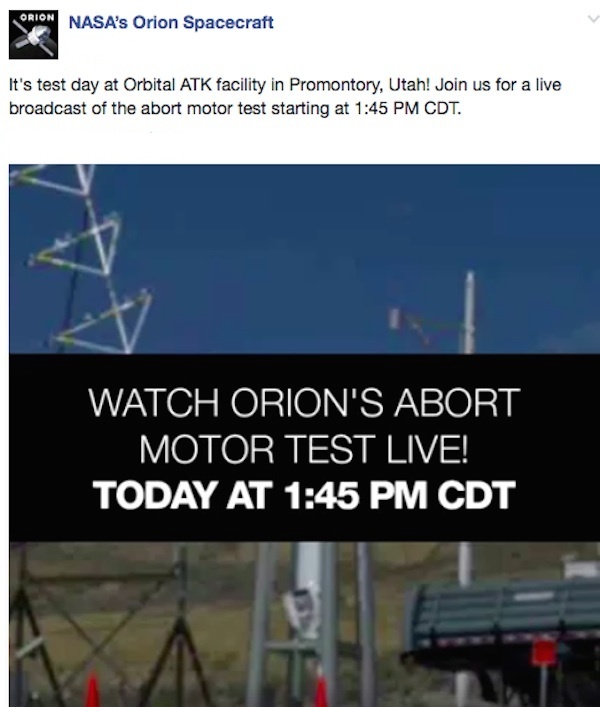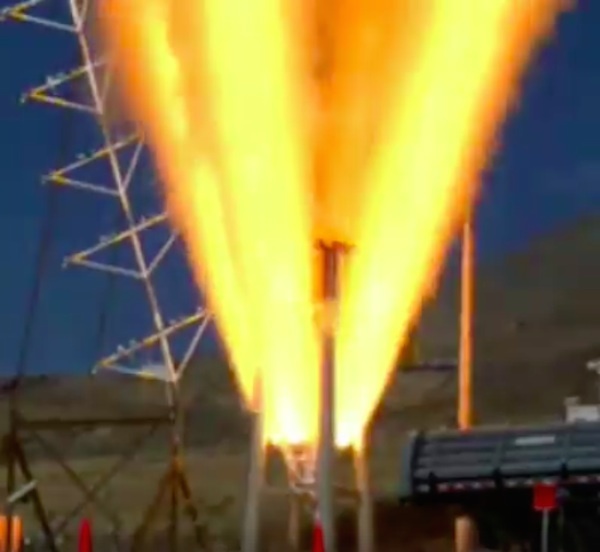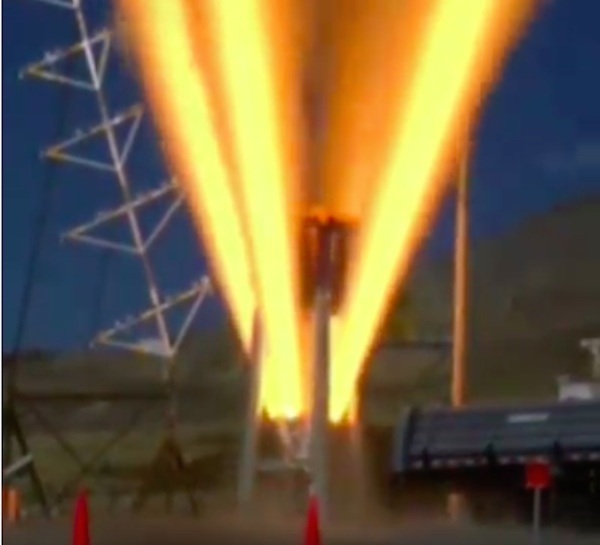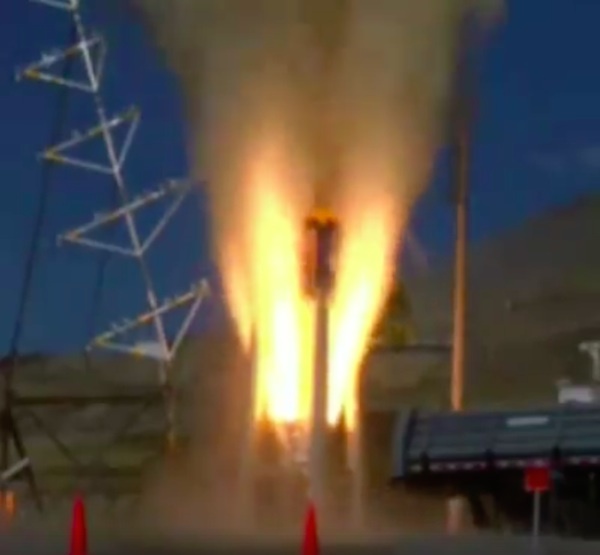Engineers working on NASA’s Orion kicked off summer with a series of important tests for some of the spacecraft’s critical safety systems. In the Utah desert, the skies over Arizona and the water at Johnson Space Center in Houston, the team is making sure Orion is safe from launch to splashdown.
Launch Abort Motor Test
At the Promontory, Utah, facility of Orion subcontractor Orbital ATK, engineers tested the abort motor for Orion’s launch abort system June 15, firing the 17-foot tall motor for five seconds. The motor was fastened to a vertical test stand with its nozzles pointed toward the sky for the test. It produced enough thrust to lift 66 large SUVs off the ground and helps qualify the system for future missions with astronauts.
“The launch abort system is an important part of making sure our crew members stay safe on the launch pad and on their way to space,” said Robert Decoursey, manager for Orion’s LAS. “It takes us another step closer to proving the safety of our spacecraft as we prepare for missions beyond the moon.”
The launch abort system is positioned on top of the Orion crew module and will play a critical role protecting future crews traveling to deep space destinations in Orion. The abort motor is responsible for propelling the crew module away from the Space Launch System rocket in case of an emergency, and one of three total motors that will send the crew module to a safe distance away from a failing rocket and orient it properly for a safe descent into the Atlantic Ocean if such a situation ever occurs.
While engineers are just getting started analyzing the data, the test verified the motor can fire within milliseconds when needed and will work as expected under high temperatures.
Parachute Testing
The team developing and building Orion’s parachute system that ensures the crew module can safely descend to Earth evaluated how the parachutes perform during a scenario in which an abort while on the launch pad is necessary. When Orion returns to Earth from deep space missions beyond the moon, the system will customarily deploy 11 parachutes in a precise sequence to help slow the crew module down from high speeds for a relatively slow splashdown in the Pacific Ocean. But the parachutes must also be capable of sending the crew module to safety if it were to be jettisoned off a failing rocket without time for the full deployment sequence to occur.
In a June 14 test at the U.S. Army Proving Ground in Yuma, Arizona, engineers dropped a mock Orion capsule out of a C-17 airplane at 25,000 feet in altitude to test how the system will fare when only Orion’s three main orange and white parachutes deploy. The test evaluated performance when the parachutes experience a low altitude and low dynamic pressure.
“Orion will take astronauts farther than we’ve been before, and an important part of successful missions in deep space is making sure we can bring them home safely, even in scenarios where something might go wrong,” said Yasmin Ali, landing and recovery systems manager for Orion. “We’re testing for all kinds of situations Orion’s parachutes could face.”
Orion’s parachutes are in the midst of being qualified for flights with astronauts and put through a variety of normal and failure scenarios over the course of eight total tests to ensure the parachutes can safely help the crew module and the astronauts inside safely descend.
Airbag Testing
This month the Orion team is also evaluating an updated design to the crew module uprighting system, the system of five airbags on top of the capsule that inflate upon splashdown. In high waves or wind over the ocean, the uprighting bags are responsible for turning Orion right side up if the capsule lands upside down or turns over when it returns to Earth. Engineers have retooled the design of the bags after they didn’t properly inflate during Exploration Flight Test-1.
The testing is taking place at the Neutral Buoyancy Lab at Johnson, where the team is performing eight tests evaluating the bags during both normal inflation and failure scenarios to validate computer models. The testing in the calm waters of the pool helps the team prepare for a late-summer complement of uprighting system tests in the Gulf of Mexico off the coast of Galveston, Texas.
“We’re making important headway this summer with all of our landing and recovery systems testing,” said Ali.
NASA is building a flexible, reusable and sustainable capability and infrastructure beyond the moon that will last multiple decades and support missions of increasing complexity. Beginning with launch of the first integrated mission of SLS and Orion, this new deep space exploration system will create a capability from which future generations will benefit.
Elkton, Maryland, Orbital ATK (NYSE: OA), a global leader in aerospace and defense technologies, today announced that is has completed analysis of the critical components demonstrated in the Orion Launch Abort System Attitude Control Motor (ACM) test conducted at the company’s Elkton, Maryland, facility. Results from the test indicate the motor’s HT-11 ‘High Thrust’ test was fully successful.
The ACM consists of a solid propellant gas generator and eight equally-spaced valves capable of providing 7,000 lbs. of thrust in any direction. The HT-11 test used a three-valve version of the ACM to verify the latest design improvements. Orbital ATK recently completed a physical review of all test hardware and an analysis of all test data to confirm that the improvements performed as expected. This key milestone clears the way for the ACM to enter into the qualification phase of the program. Three qualification units will undergo additional static testing in 2018 and 2019, also at Orbital ATK’s controllable propulsion center of excellence in Elkton. Founded in 1948, the 550-acre facility employs more than 400 employees, principally engaged in engineering and manufacturing. It is recognized as an AIAA Historic Aerospace Site.
“For decades, Orbital ATK has been an important component of Maryland’s thriving aerospace industry and of America’s accomplishments in space,” said Maryland Commerce Secretary Mike Gill. “This collaboration between NASA, Lockheed Martin, and Orbital ATK not only illustrates the strength of aerospace in Maryland, but also advances space exploration far beyond our horizon.”
The launch abort system (LAS), which is being developed by Lockheed Martin for NASA’s Orion spacecraft, will protect the astronaut crew on the launch pad and during ascent. Orion is being built to take humans farther than they’ve ever gone before. NASA is building a flexible, reusable and sustainable capability and infrastructure beyond the moon that will last multiple decades and support missions of increasing complexity. Orbital ATK is providing key propulsion subsystems for the LAS, including an advanced ACM to safely control the LAS during the main abort phase and to reposition the capsule for descent and parachute release.
Quelle: Orbital ATK
---
Update: 5.07.2017
.
Throughout NASA’s 43-acre rocket factory, the Michoud Assembly Facility in New Orleans, engineers are building all five parts of the Space Launch System’s core stage. For the first SLS flight for deep space exploration with NASA’s Orion spacecraft, major structural manufacturing is complete on three parts: the forward skirt, the intertank and the engine section. Test articles, which are structurally similar to flight hardware, and are used to qualify the core stage for flight, are in various stages of production and testing.
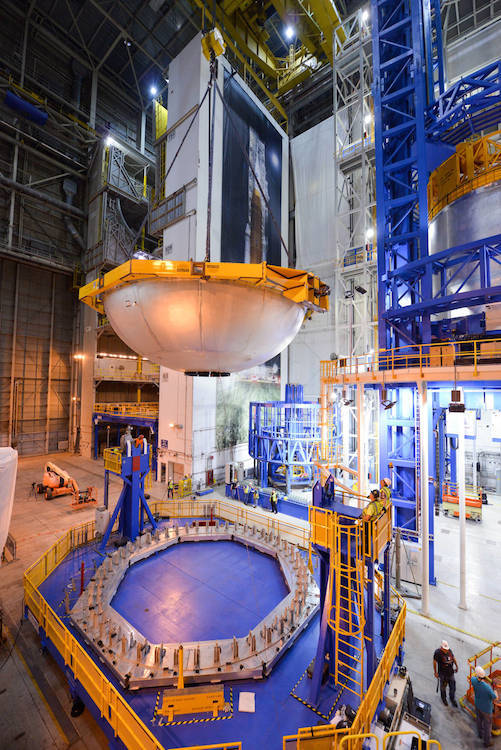
“One of the most challenging parts of building the world’s most powerful rocket has been making the largest rocket stage ever manufactured for the first time,” said Steve Doering, the SLS stages manager at NASA’s Marshall Space Flight Center in Huntsville, Alabama. “The 212-foot-tall core stage is a new design made with innovative welding tools and techniques.”
To build the rocket’s fuel tanks, Boeing, the prime contractor for the SLS core stage, is joining some of the thickest parts ever built with self-reacting friction stir welding. NASA and Boeing engineers and materials scientists have scrutinized the weld confidence articles and developed new weld parameters for making the liquid oxygen and hydrogen tanks for the first SLS mission.
Resuming Welding in the Vertical Assembly Center
The Vertical Assembly Center, the large robotic tool where core stage parts are welded to form major structures, is expected to resume manufacturing next week. NASA halted production in early May after a liquid oxygen tank dome was inadvertently damaged during pre-weld preparations on the infeeder tool. This equipment is what positions the large dome for welding, or feeds it into the tank.
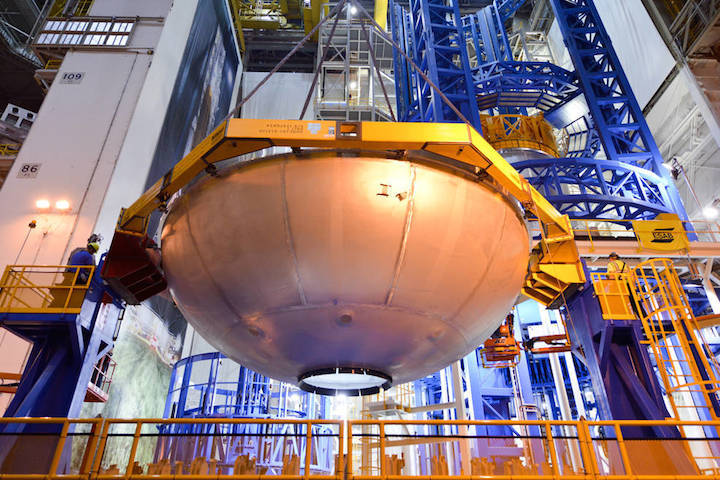
While the mishap investigation is still wrapping up, NASA and Boeing fully inspected the impacted dome and found while the hardware sustained minor damage, it is usable for its original purpose as part of a structural test article. The infeeder tool did sustain some damage during the incident and repairs to the tool are complete. Welding is resuming to finish construction of the liquid oxygen test article by adding the aft, or bottom, dome. Upon completion, the tank will undergo inspection for any flaws, final processing and proof testing.
In another area of the factory, domes and segments for the flight liquid oxygen tank await their turn to be joined on the VAC, and Boeing is now completing welding domes and barrels that will make up the liquid hydrogen tank for flight. Recently, major structural construction was completed on flight hardware for the one part of the core stage structure not welded. The intertank walls are too thick to be welded, so its eight panels are connected with 7,500 bolts. The walls have to be extremely strong because of the force it feels from the solid rocket boosters attached to it. To complete assembly on the inside of the core stage, the team is outfitting the intertank along with the flight forward skirt and the engine section structures, with avionics, wire harnesses, tubing, sensors, and propulsion systems.
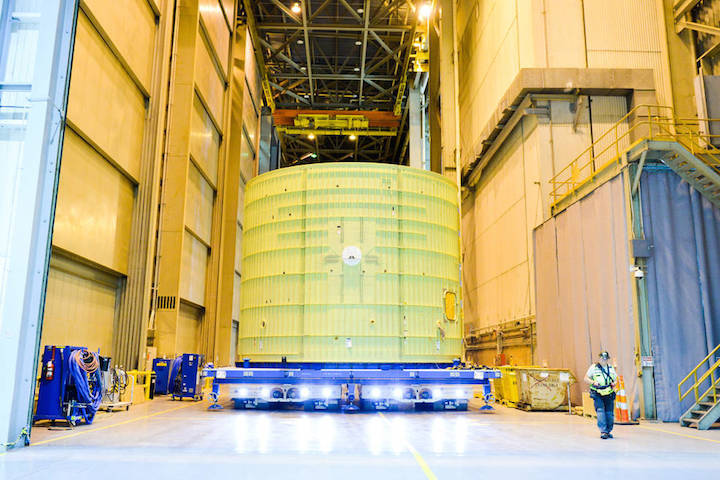
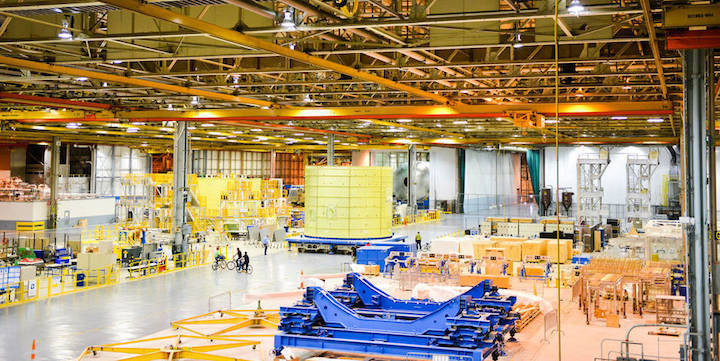
Preparing Hardware for Testing
NASA and Boeing continue to prepare existing hardware for tests to help ensure success of the first SLS flight and crew safety on future missions. Before the tanks are hooked up to feed propellant to the four RS-25 engines or through a test stand propellant system, the tanks have to be cleaned to avoid any contamination. Though the liquid hydrogen structural test article is not fueled, the tank has recently been moved to the cleaning cell to certify the process ahead of the flight tank.
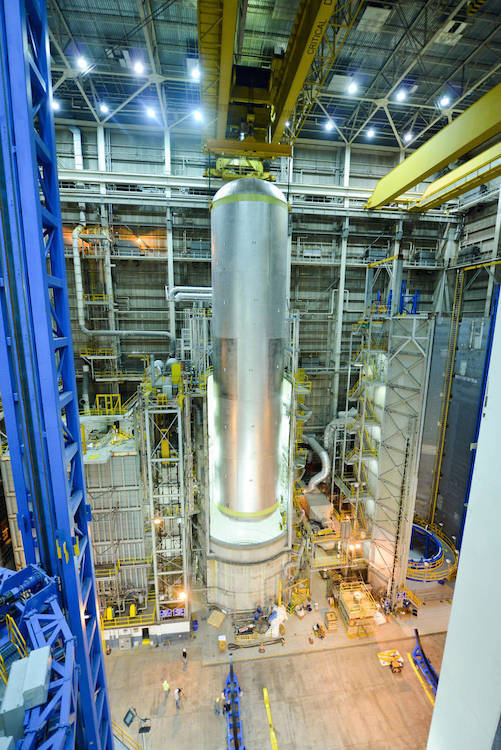
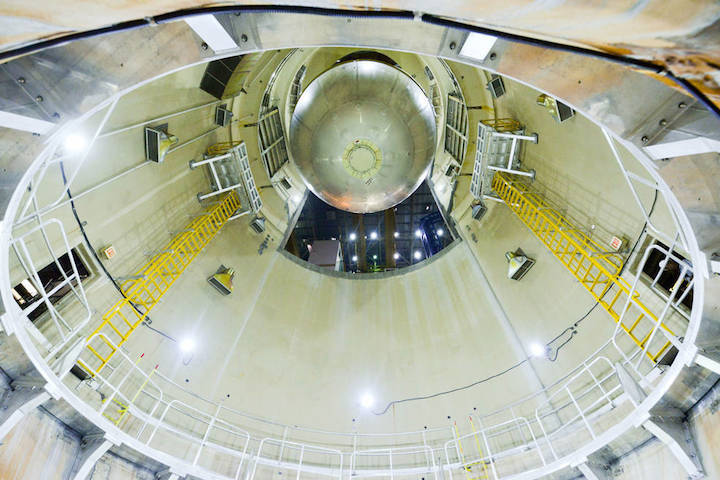
The first structural test article for SLS, an engine section which is similar to the flight article located at the bottom of the rocket’s core stage, is being installed on a test stand at NASA’s Marshall Space Flight Center in Huntsville, Alabama. Hydraulic cylinders will push, pull, twist and bend the engine test article to validate the design and ensure it can withstand the pressure expected during launch and ascent.
“We are conducting the largest NASA launch vehicle test campaign since space shuttle development,” said John Honeycutt, the SLS program manager at Marshall. “The team is focused on delivering hardware to the pad for the first launch. We just completed integrated structural testing for the stage that will send Orion out beyond the moon on the first flight. Now, we’ll be putting the core stage parts through the paces to gain an in-depth understanding of the rocket we are building for the first time as we expose parts of it to the extreme conditions of spaceflight.”
Quelle: NASA
---
Update: 7.07.2017
Orion deep in processing for EM-1, planning for following missions

As US Vice President Mike Pence visited the Kennedy Space Center (KSC), one of the welcoming party, the Orion crew module, is fast taking shape ahead of its Exploration Mission-1 (EM-1) flight. With major processing milestones – such as the mating of the heatshield with the Crew Module, NASA managers are already thinking ahead to future flights involving Orion.
Crew Module status:
The crew module is in the Operations and Checkout (O&C) Building at the Kennedy Space Center (KSC) in Florida, where the system components are being integrated with the vehicle structure.
“The EM-1 crew module is well on its way,” Lara Kearney said in an interview with NASASpaceflight.com. Kearney is manager of the Orion Crew and Service Module Office at NASA’s Johnson Space Center in Houston, Texas.
“The pressure vessel was down at Kennedy well over a year ago and then last summer basically was an influx of all of the components that are then assembled to that pressure vessel like the propulsion components, life support components, a lot of our landing and recovery systems like our airbags [and] our parachutes.
“So all these components were delivered over the course of this past year and then the assembly team down at Kennedy is putting it all together. The life support system is already installed, the prop system is already installed, they have been leak-checked and are ready to go. We just installed our main parachutes, so they’re stowed in the forward bay and they’re ready to go.”
With Lockheed Martin the prime contractor for Orion, the pressure vessel for the crew module is welded in an area of the expansive, multi-user Michoud Assembly Facility in New Orleans, Louisiana. The EM-1 pressure vessel is the third iteration of the structure.
“For Exploration Flight Test-1 (EFT-1), we had eighteen welded parts [that weighed] about 3300 pounds. With Exploration Mission-1, we’re down to seven welded parts and 2700 pounds,” Kearney noted.
EFT-1 was the first test flight of the Orion crew module (CM) and mass simulators standing in for the service module elements in December, 2014. The first pressure vessel article built was a Ground Test Article that was used for testing at different facilities.
“It was at 31 welded parts and 3900 pounds. That was kind of the first attempt at the primary structure,” Kearney added.

After welding was completed, the pressure vessel was shipped to KSC in early February, 2016.
“We’re always dealing with mass and trying to control mass,” she noted. “As something grows, something else has to come down, but we’re getting to the point now where we’re really trying not to continue to redesign the primary pressure vessel components, simply because that just takes money to do that.
“We’re going to have to go after other components that are not yet fully designed, like the items that are coming on EM-2, like the life support components and such. Same with the heatshield, we’re trying to lock that heatshield in and not redesign it.”
Heatshield changes:
One of the major changes to the crew module between EFT-1 and EM-1 was to the base heatshield that attaches to the bottom of the crew module. The Orion crew module incorporates the same outer moldline as the Apollo command module, but is larger in size. The heatshield design that flew on EFT-1 was also ‘scaled up’ from Apollo.

“On EFT-1, it was basically what we called a ‘monolithic’ heatshield,” Kearney explained. “There was a small honeycomb structure that covered the composite skin with hundreds of thousands of little cells that were filled with this ablative material [Avcoat] that for all intents and purposes created a single, monolithic ablative shell that covered the bottom of the heatshield.
“We’re now using that same ablative material, but manufacturing it into these blocks and then adhering these blocks to that composite structure.
“So that’s the fundamental architecture change and ultimately we did that for a couple of reasons. One, that monolithic design was having some structural/mechanical challenges that we can overcome by going to these blocks and the block architecture is a lot less intensive from a manufacturing perspective. So it’s fundamentally a lower life-cycle cost option for us.”

Kearney said work on heatshield assembly at KSC is progressing towards its Autumn date for integration with the Crew Module it will be tasked with protecting during re-entry.
“The titanium structure along with the composite skin, we’ve been bonding all the tile blocks to it. All of the blocks are now on and in place and ready to go and they’re now moving into the process of what we call filling the gaps between all of those blocks and that heatshield will be installed onto the crew module in the fall time-frame.”
Although the blocks of the ablative material are fundamentally different from the insulating tiles on the Space Shuttle, they are attached to the structure and to each other in a similar fashion.
“They’re adhered by an adhesive to the underlying structure and then this gap filler is there between them to hold them all together,” she said, adding the gap filler for the Avcoat blocks was a ‘RTV-like’ material (RTV is short for Room Temperature Vulcanizer) that will cure in the gaps.
The EM-1 mission will be the first opportunity to test Orion’s re-entry to Earth’s atmosphere at lunar return speeds. The spacecraft reached a velocity of approximately 20000 miles per hour during the EFT-1 entry, descent, and landing (EDL). For re-entries from the Moon, Orion will reach speeds of approximately 25000 mph.
Service Module integration:
The EM-1 mission will exercise the new capabilities added to Orion since the short EFT-1 mission in low Earth orbit.
In contrast to EFT-1, Orion will fly with a fully functional European Service Module (ESM).

The ESM gives Orion propulsion, power, and thermal control capabilities to allow it fly on its own into and out of lunar orbit. The ESM will also carry air and water provisions on future crewed flights.
The Orion flight software is also evolving on EM-1 to integrate and control the added capabilities, including expanded guidance, navigation, and control (GNC) functionality and communications networking needed to fly beyond Earth orbit.
A separate element, the Crew Module Adapter (CMA), sits between the CM the ESM.
“It’s the Crew Module Adapter that actually physically mates the ESA (European Space Agency) Service Module to the Crew Module and it’s through that Crew Module Adapter that all the interfaces flow, so all the gasses, power, data, all that kind of stuff flows through that adapter,” Kearney explained.
“That’s basically where our interface control is held is in that Crew Module Adapter. When the ESA Service Module comes to us, it’ll be mated within this service module structure that Lockheed is currently building down at the O&C in Florida.”

Lockheed Martin builds those other Service Module components, the CMA, the Service Module fairing panels, and the spacecraft adapter.
On EM-1, launch on the Space Launch System (SLS) vehicle and Interim Cryogenic Propulsion System (ICPS) upper stage puts Orion on a week-long translunar trajectory; when the spacecraft reaches the Moon, it will fire its engines to maneuver into a Distant Retrograde Orbit.
After remaining in that orbit for approximately a week, the spacecraft will perform another set of maneuvering burns to leave lunar orbit and return to Earth about a week later.
The first ESM, Flight Model-1, is being integrated at an Airbus Defence and Space facility in Bremen, Germany. Airbus is the prime contractor for the ESM.

As with other EM-1 spacecraft and launch vehicle elements being designed, developed, and assembled for the first time, its readiness date has been delayed, with current estimates that it will ship to KSC late this year or early next.
Once the ESM arrives at KSC, it will be mated with the rest of the Service Module elements. It will be mated to the CMA and have its Orbital Maneuvering Engine (OME) nozzle re-attached. The spacecraft adapter that connects with the launch vehicle will also be attached. The integrated Service Module will then be mated to the CM, forming the “Short Stack.”
The mated spacecraft and accompanying hardware (such as Service Module fairing panels and solar arrays) will then be transported from KSC to the Plum Brook Station test facility at NASA’s Glenn Research Center in Ohio for integrated environmental testing such as vacuum and acoustic tests.
The spacecraft and hardware will then all return to KSC for final launch preparations, where the crew and service modules will be fueled with maneuvering propellant and integrated with the launch abort system for final mating to the launch vehicle.
EM-2 and beyond:
The final major development phase for Orion is planned between EM-1 and EM-2, which is the first mission that will fly crew.
Most of the Environmental Control Life Support System (ECLSS) and crew systems will be developed to integrate with the rest of the spacecraft systems for the first time.

“Basically that’s everything that comes along with the crew – so that’ll be the flight seats, the [space]suits, the umbilicals that go along with that, all of the what we call flight crew equipment which is the stuff they carry on board with them,” Kearney explained.
“Things like air monitors and fire extinguishers and food, water dispensers, those kind of things. The displays and controls will be new on EM-2 and then of course the life support system that is associated with the air circulating system, the carbon dioxide removal system, and the water system that’s cooling the crew will all be new on EM-2.”
The spacesuits for the early Orion missions are derived from the launch and entry suits worn by crews for most of the Space Shuttle program.
“The big difference is that Shuttle is what we called open loop — where the oxygen system flows to the suits and then the crew would breathe and then the suits would dump overboard into the Shuttle cabin,” Kearney explained.

“On Orion, we’re [a] closed loop system, and so that’s the change from the Shuttle suits is that we’ve closed them up. We have a circulating system between the life support [system] on the crew module that flows into the suits in a closed loop.”
Although there will be little ECLSS functionality on EM-1, some hardware will fly in the crew module to collect environmental data.
“We are flying a couple of seats and some mannequins inside, collecting some radiation data on them,” Kearney added. “For the most part it’s [those] mass simulators [and] some cameras. The suited quote ‘dummies’ [are] anthropometric crash test dummy kind of things.”
For the EM-2 mission, current plans are to fly a more conservative circumlunar profile, with an extended checkout period in high Earth orbit first. If everything checks out satisfactorily, Orion would then make a single flyby of the Moon and return to Earth for splashdown.

The other major objective for the EM-2 mission is for the SLS to put the first element of a Deep Space Gateway (DSG), a Power and Propulsion Element (PPE), on a translunar trajectory.
In what is called a “Multi Translunar Injection” (MTLI) flight profile, the SLS will perform separate burns to partially deliver Orion to one translunar trajectory and completely send the PPE to another.
After reaching an initial parking orbit around Earth, the SLS would first raise the apogee of the orbit to a high-altitude with an orbital period of about 24 hours, which will allow an extended checkout of Orion while remaining close to Earth on its first flight with crew.
Shortly after that burn ends, Orion would separate to a safe distance from SLS with the PPE. Then SLS would then restart to complete a Translunar Injection (TLI) burn with the PPE. Meanwhile, Orion would stay in the highly elliptical Earth orbit until the next day when it would perform its own burn to complete its TLI, which would put the spacecraft and crew on a free-return trajectory.

After separating from SLS, the PPE will use its own propulsion systems once it reaches the Moon to insert itself into a Near Rectilinear Halo Orbit (NRHO), where subsequent Exploration Missions will rally with supplies and additional DSG elements.
The next Exploration Mission, EM-3, is tentatively planned to rendezvous and dock with the Power Propulsion Element in lunar orbit and Rendezvous, Proximity Operations, and Docking (RPOD) is one of the additional capabilities that will be added to Orion after EM-2.
“The plan right now is to work towards the docking capability for EM-3,” Kearney said. “We’re at the very beginning of that process,…but our budgetary plans right now are laid out to support docking on EM-3.”
On EM-3 the SLS launcher would perform a TLI burn with both Orion and a habitation module for the DSG. On their way to the Moon, the Orion would then separate from the SLS upper stage, turn around, and dock to the Hab module.
After the mated Orion and Hab module separated from the booster, they would continue into the lunar halo orbit, where they would rendezvous and dock with the PPE.
Quelle: NS

